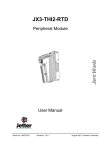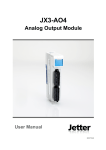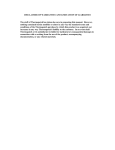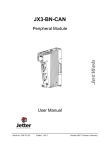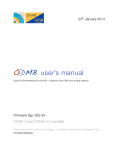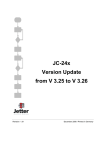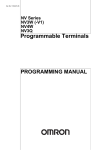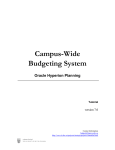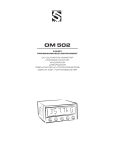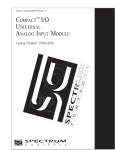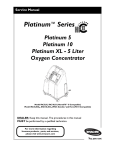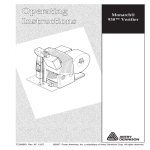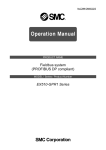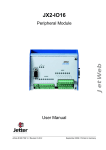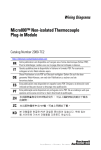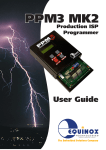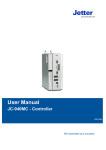Download User manual
Transcript
JX3-THI2-TC JetWeb Peripheral Module User Manual Article no.: 60872697 Revision: 1.01.2 March 2008 / Printed in Germany Introduction JetWeb Revision 1.01.2 Jetter AG reserve the right to make alterations to their products in the interest of technical progress. These alterations need not be documented in every single case. This manual and the information contained herein have been compiled with due diligence. However, Jetter AG assume no liability for printing or other errors or damages arising from such errors. The brand names and product names used in this document are trademarks or registered trademarks of the respective title owner. 2 Jetter AG JX3-THI2-TC Introduction How to Contact us: Jetter AG Gräterstrasse 2 D-71642 Ludwigsburg Germany Phone - Switchboard: Phone - Sales: Phone - Technical Hotline: +49 7141 2550-0 +49 7141 2550-433 +49 7141 2550-444 Fax - Sales: E-mail - Sales: E-mail - Technical Hotline: +49 7141 2550-484 [email protected] [email protected] This User Manual is an Integral Part of the JX3-THI2-TC Module: Type: Serial #: Year of construction: Order #: To be entered by the customer: Inventory #: Place of operation: © Copyright 2007, 2008 by Jetter AG. All rights reserved. Jetter AG 3 Introduction JetWeb Significance of this User Manual This manual is an integral part of the JX3-THI2-TC module, and • • must be kept in a way that it is always at hand until the JX3-THI2-TC module will be disposed of. If the JX3-THI2-TC is sold, alienated or loaned, this manual must be handed over. In any case you encounter difficulties to clearly understand this user manual, please contact the manufacturer. We would appreciate any suggestions and contributions on your part and would ask you to contact us. This will help us to produce manuals that are more user-friendly and to address your wishes and requirements. This manual contains important information on how to transport, erect, install, operate, maintain and repair the JX3-THI2-TC module. Therefore, the persons carrying out these jobs must carefully read, understand and observe this manual, and especially the safety instructions. Missing or inadequate knowledge of the manual results in the loss of any claim of liability on part of Jetter AG. Therefore, the operating company is recommended to have the instruction of the persons concerned confirmed in writing. History 4 Revision Comment 1.01.1 Original issue 1.01.2 Changes, see Recent Revisions (on page 67) Jetter AG JX3-THI2-TC Introduction Description of Symbols This sign is to indicate a possible impending danger of serious physical damage or death. Warning This sign is to indicate a possible impending danger of light physical damage. This sign is also to warn you of material damage. Caution This sign indicates hazard of life due to electric shock caused by a high operating voltage. Warning This sign is to indicate hazard of serious physical damage or death due to accidentally touching dangerous parts of the device. Warning You have to wear goggles. Failure to comply may lead to bodily injuries. Warning This sign is to warn you of material damage due to applying hard blows or shocks to the motor flange and shaft. This sign is to indicate a possible impending situation which might bring damage to the product or to its surroundings. It also identifies requirements necessary to ensure faultless operation. Important Jetter AG 5 Introduction JetWeb You will be informed of various possible applications and will receive further useful suggestions. It also gives you words of advice on how to efficiently use hardware and software in order to avoid unnecessary efforts. Note ·/- Enumerations are marked by full stops, strokes or scores. Operating instructions are marked by this arrow. Automatically running processes or results to be achieved are marked by this arrow. Pictorial representation of PC and HMI keys. Reference to a program or file. This symbol informs you of additional references (data sheets, literature, etc.) associated with the given subject, product, etc. It also helps you to find your way around this manual. 6 Jetter AG JX3-THI2-TC Table of Contents Table of Contents 1 Safety Instructions 11 1.1 Generally Valid Safety Instructions .......................................................... 11 1.1.1 Intended Conditions of Use of the JX3-THI2-TC ............................. 11 1.1.2 Usage other than intended .............................................................. 11 1.1.3 Who may operate the device?......................................................... 12 1.1.4 Modifications and Alterations to the Module.................................... 12 1.1.5 Repair and Maintenance ................................................................. 12 1.1.6 Decommissioning and Disposing of ................................................ 12 1.2 Ensure Your Own Safety ......................................................................... 13 1.2.1 Malfunctions .................................................................................... 13 1.2.2 Information Signs and Labels.......................................................... 13 1.3 Instructions on EMI .................................................................................. 14 2 Introduction 2.1 2.2 2.3 2.4 3 4 Description of the JX3-THI2-TC Module .................................................. 15 JX3-THI2-TC - Minimum Requirements................................................... 16 JX3-THI2-TC - Scope of Delivery ............................................................ 16 List of Documentation .............................................................................. 17 Description of Connections 3.1 3.2 3.3 3.4 15 19 JX3-THI2-TC - Functional Data of Temperature Inputs ........................... 19 JX3-THI2-TC - Assignment of Terminals X41 and X42 ........................... 20 Connecting Thermocouples ..................................................................... 21 Improving the Noise Immunity ................................................................. 22 Numbering of Registers and I/Os 23 4.1 Register Addressing ................................................................................ 23 4.1.1 Register Array for JX3 Modules ...................................................... 23 4.1.2 Direct Access to JX3 Module Registers .......................................... 26 4.1.3 Indirect Access to JX3 Module Registers ........................................ 27 5 Commissioning the JX3-THI2-TC Module 31 5.1 Approach to Commissioning the Module ................................................. 31 5.1.1 Fast Commissioning of the JX3-THI2-TC Module ........................... 31 6 Digitizing the Analog Values 6.1 6.2 6.3 6.4 Jetter AG 33 Registers with Digitized Analog Value ..................................................... 33 Displaying the Temperature..................................................................... 33 Accuracy as a Function of Noise ............................................................. 34 Variation at 10-fold Averaging ................................................................. 34 7 Table of Contents 7 Status and Instructions JetWeb 35 7.1 JX3-THI2-TC: Allowed Thermocouple Types .......................................... 39 8 Additional Functions 8.1 8.2 8.3 8.4 8.5 8.6 9 41 Additional Functions - Overview .............................................................. 41 A/D Conversion........................................................................................ 44 Averaging ................................................................................................ 44 Monitoring of Limits.................................................................................. 45 Slave Pointer ........................................................................................... 46 Transfer to the Controller......................................................................... 46 Oscilloscope 47 9.1 Operating Principle .................................................................................. 47 9.1.1 Oscilloscope Mode - Technical Data ............................................... 47 9.2 Recordings via Oscilloscope.................................................................... 47 9.3 Triggering a Recording Session............................................................... 48 9.4 Module Registers - Overview................................................................... 49 9.5 Recordings via Application Program........................................................ 52 10 Forcing Analog Inputs 55 10.1 JX3-THI2 - Functional Principle of Forcing .............................................. 55 10.2 Forcing - Module Register ....................................................................... 56 11 Diagnostics and Administration 11.1 11.2 11.3 11.4 57 JX3-THI2-TC: Behavior in case of errors:................................................ 57 Diagnostic Indicators (LEDs) ................................................................... 57 Diagnostics via JX3 Module Registers..................................................... 58 Electronic Data Sheet (EDS) ................................................................... 62 12 Recent Revisions 67 13 Module Registers - Overview 69 13.1 Overview - JX3-THI2-TC Module Registers............................................. 69 13.2 Table - JX3-THI2-TC Module Registers................................................... 70 14 Design 73 14.1 Physical Dimensions................................................................................ 73 14.2 JX3-THI2-TC Terminals........................................................................... 74 15 Operating Conditions 8 75 Jetter AG JX3-THI2-TC 15.1 15.2 15.3 15.4 Table of Contents Environment and Mechanics ................................................................... 75 Enclosure................................................................................................. 76 DC Power Supply Inputs and Outputs ..................................................... 77 Shielded Data and I/O Lines.................................................................... 78 16 Technical Data 79 17 General Information 81 18 Glossary – Peripheral Modules 85 19 List of Illustrations 87 20 Index 89 Jetter AG 9 Table of Contents 10 JetWeb Jetter AG JX3-THI2-TC JetWeb 1 Safety Instructions 1.1 Generally Valid Safety Instructions This device complies with the valid safety regulations and standards. Special emphasis was given to the safety of the users. Of course, the user should adhere to the following regulations: • • • 1.1.1 relevant accident prevention regulations; accepted safety rules; EC guidelines and other country-specific regulations. Intended Conditions of Use of the JX3-THI2-TC The intended conditions of use include operation in accordance with the user manual. The JX3-THI2-TC module is a JX3 expansion module equipped with two analog inputs for connecting analog temperature sensors. It can be connected to the JX3 system bus. The JX3 system bus starts at the JX3-BN-xxx module. Via JX3-BN-CAN module, the JX3THI2-TC module can be connected to all controllers of the JetControl series. The JX3BN-XXX or JX3-PS1 module supplies the JX3-THI2-TC module with voltage. This operating voltage is classified as SELV (Safety Extra Low Voltage). The JX3-THI2-TC module is therefore not subject to the EU Low Voltage Directive. The JX3-THI2-TC module may only be operated within the limits of the stated specifications. The device is used to control machinery, such as conveyors, production machines, and handling machines. 1.1.2 Usage other than intended This device must not be used in technical systems which to a high degree have to be failsafe, e.g. ropeways and aeroplanes. If the device is to be run under ambient conditions which differ from the conditions mentioned in chapter Operating Conditions (page 75), the manufacturer is to be contacted beforehand. Jetter AG 11 JX3-THI2-TC 1.1.3 JetWeb Who may operate the device? Only instructed, trained and authorized persons are permitted to operate this device. Transport: Installation: Commissioning: 1.1.4 Only by personnel with knowledge in handling electrostatically sensitive components. Only by specialists with training in electrical engineering. Only by specialists with profound knowledge of, and experience with, electrical engineering / drive technology. Modifications and Alterations to the Module For safety reasons, no modifications and changes to the device and its functions are permitted. Any modifications to the device not expressly authorized by the manufacturer will result in a loss of any liability claims to Jetter AG. The original parts are specifically designed for the device. Parts and equipment from other manufacturers are not tested on our part, and are, therefore, not released by us. The installation of such parts may impair the safety and the proper functioning of the device. Any liability on the part of Jetter AG for any damages resulting from the use of non original parts and equipment is excluded. 1.1.5 Repair and Maintenance This device must not be repaired by the operators themselves. The device does not contain any parts that could be repaired by the operator. The device must be sent to Jetter AG for repair. 1.1.6 Decommissioning and Disposing of The environmental regulations of the respective country must be complied with when decommissioning and disposing of devices on the operating company's premises. 12 Jetter AG JX3-THI2-TC 1.2 JetWeb Ensure Your Own Safety Disconnect the JX3-THI2-TC module from the mains to carry out maintenance work. By doing so, you will prevent accidents resulting from electric voltage and moving parts. Warning Safety and protective devices, e.g. the barrier and cover of the terminal box must never be shunted or by-passed. Dismantled protective equipment, such as guards, must be reattached prior to commissioning and checked for proper functioning. Prior to commissioning, the machine manufacturer shall conduct a hazard analysis for the machine and take appropriate measures to prevent personal injury and damage to property resulting from accidental movements. 1.2.1 Malfunctions In case of failures or damages, disconnect the device from the mains immediately. Malfunctions or other damages are to be reported to a responsible person at once. The device must be protected from improper or inadvertent use. 1.2.2 Information Signs and Labels Markings, information signs, and labels always have to be observed and kept readable. Damaged or unreadable information signs and labels have to be replaced. Jetter AG 13 JX3-THI2-TC 1.3 JetWeb Instructions on EMI The noise immunity of a system depends on the weakest component of the system. For this reason, correct wiring and shielding of cables is of paramount importance. Important! Measures for increasing EMI in electric plants: The JX3-THI2-TC module has to be attached to a DIN rail acc. to EN 50022-35 x 7.5. If correct measurements are required, the sensor cables connected to inputs X41 and X42 of the JX3-THI2-TC module have to be looped through a ferrite core at least once or twice. This way, external interferences can be minimized. This reduction of interferences can be achieved by using a round cable snap ferrite (e.g. by Würth Elektronik, part # 74271222). Tests with an RF injection (10 V/m) resulted in a higher susceptibility to interference. The measuring accuracy decreased from 0.5°C to 1.5°C in the range of up to 450°C. Follow the instructions given in Application Note 016 "EMC-Compatible Installation of the Electric Cabinet" published by Jetter AG. The following instructions are excerpts from Application Note 016: On principle, physical separation should be maintained between signal and voltage lines. We recommend spacings greater than 20 cm. Cables and lines should cross each other at an angle of 90°. Shielded cables are to be used for the following lines: Analog lines, data lines, motor cables coming from inverter drives (servo output stage, frequency converter), lines between components and interference suppressor filter, if the suppressor filter has not been placed at the component directly. Shield cables at both ends. Unshielded wire ends of shielded cables should be as short as possible. The entire shield must be drawn behind the isolation, and then be clamped under an earthed strain relief with the greatest possible surface area. 14 Jetter AG JX3-THI2-TC JetWeb 2 Introduction 2.1 Description of the JX3-THI2-TC Module The JX3-THI2-TC module is a JX3 expansion module for connecting thermocouples. This module is equipped with 2 inputs. Via JX3-BN-CAN module, the JX3-THI2-TC module can be connected to all controllers of the JetControl series. Description of the JX3-THI2-TC Module Jetter AG Article # 10000611 Module Code 312 LED Display Terminal X41 Supply Voltage Communication Hardware error 1 input for connecting thermocouples Terminal X42 1 input for connecting thermocouples Additional functions • • • • • • • Averaging Monitoring and evaluation of limits Operating system update by means of JetSym Slave pointer Oscilloscope function Potentiometer mode Forcing 15 JX3-THI2-TC 2.2 JetWeb JX3-THI2-TC - Minimum Requirements The functions described in this document make the following minimum requirements to modules, controllers and software. Minimum Requirements Module / Controller / Software JX3-THI2-TC V 1.01.0.01 JX3-BN-CAN V 1.04 JC-24x V 3.23 Oscilloscope Function: V 3.24 V 2.18 Oscilloscope Function: V 2.19 V 3.50 JX6-SB / JX6-SB-I JC-64x JetSym V 3.00 Oscilloscope Function: V 4.00 V 1.12 Oscilloscope Function: V 1.13 JM-D203-JC-24x 2.3 Starting from software release JX3-THI2-TC - Scope of Delivery JX3-THI2-TC - Scope of Delivery Article # 16 Quantity Description 10000611 1 JX3-THI2-TC 60869252 2 60870411 10 60871941 1 BU_10_BLZF_SW_RM3.5 10-pin male connector, spring cage technology, contact spacing 3.5 mm DIV_DEK_5/5_MC-10_NEUT._WS Terminal labels Installation instruction 60870410 1 DIV_BL_SL_3.5_KO_OR Keying pins Jetter AG JX3-THI2-TC 2.4 JetWeb List of Documentation Document Survey of the JX3-I/O System JX3-I/O System - User Information JX3-THI2-TC - Installation Instructions Jetter AG 17 JX3-THI2-TC 18 JetWeb Jetter AG JX3-THI2-TC JetWeb 3 Description of Connections 3.1 JX3-THI2-TC - Functional Data of Temperature Inputs Functional Data Input quantity: Two independent channels for thermocouples Conversion time for measured temperature approx. 90 to 150 ms in "slow mode" approx. 8 to 15 ms in "fast mode" The conversion time depends on the measured temperature. 0,01°C Resolution Accuracy Filtering Jetter AG See chapter “Accuracy/Noise”. Cold-junction typically < 4 °C. 10-fold averaging, ambient temperature 25°C, accuracy to DIN IEC 60584, class A Software filtering, 2- to 64-fold averaging, moving average 19 JX3-THI2-TC 3.2 JetWeb JX3-THI2-TC - Assignment of Terminals X41 and X42 Assignment of Terminal X41 View Analog input # 1 Pin Signal Comment X41.I1+ X41.U1+ I1+ U1+ X41.U1X41.I1- U1I1- X41.0V X41.BR1 0V NC Jumper to 0V Terminal for the positive side of thermocouple 1 Jumper to 0V Terminal for the negative side of thermocouple 1 Ground not connected X41.BR2 X41.0V X41.SHLD X41.SHLD NC 0V SHLD SHLD not connected Ground Shielding terminal Shielding terminal Assignment of Terminal X42 View Analog input # 3 Pin Signal Comment X42.I2+ X42.U2+ I2+ U2+ X42.U2X42.I2- U2I2- X42.0V 0V Jumper to 0V Terminal for the positive side of thermocouple 2 Jumper to 0V Terminal for the negative side of thermocouple 2 Ground X42.BR3 X42.BR4 NC NC not connected not connected X42.0V X42.SHLD X42.SHLD 0V SHLD SHLD Ground Shielding terminal Shielding terminal This configuration applies to Rev00. Rev01 will no longer require additional jumpers. Please use only the provided connectors by Weidmüller (order # 60869252), or identical connectors. If BL-IO-3.5 LED is used, incorrect measurements will result as the electronic parts integrated into the connector influence the measurements. 20 Jetter AG JX3-THI2-TC 3.3 JetWeb Connecting Thermocouples Between I1+ and U1-, as well as between U1- and 0V for the first channel, or I2+ and U2-, as well as between U2- and 0V for the second channel two jumpers have to be plugged in. These jumpers must designed in a way to ensure that the resistance between the terminals is significantly less than 0.1 Ω. This configuration applies to Rev00. Figure 1: Connecting a Thermocouple Jetter AG 21 JX3-THI2-TC 3.4 JetWeb Improving the Noise Immunity For improving the noise immunity, please give heed to the following rules: • • • • For the connection of analog sensors, use a shielded connector. Connect the shielding to terminal X41, respectively X42 directly. Use a shielding terminal (1) for additionally earthing the shield of the wire. Use a round cable snap ferrite (e.g. 74271222 by Würth Elektronik). Figure 2: Additional earthing of a shield by means of a shielding terminal 22 Jetter AG JX3-THI2-TC JetWeb 4 Numbering of Registers and I/Os 4.1 Register Addressing 4.1.1 Register Array for JX3 Modules Each JX3 module is equipped with over 10,000 module registers. The module registers, on the other hand, have been assigned to the controller registers. By means of registers, process, configuration and diagnose data can be read by module JX3-THI2-TC, respectively written to the module. Registers can be accessed directly in the application program of the controller, in a setup pane of JetSym, or via the user interface directly. Register Number 3 0 0 z Module Register Number The meaning depends on the module Register prefix The meaning depends on the controller The register number results from a register prefix and a module register number. The register prefix depends on the position of the JX3-THI2-TC module in the Jetter system bus, and on the controller that is applied. At determining the register prefixes, the following parameters have to be considered: • • • Jetter AG Controller (JC-24x, JC-64x, JC-800, JM-D203-JC-24x) Submodule position (at JX6-SB, JX6-SB-I) I/O module number in the Jetter system bus 23 JX3-THI2-TC JetWeb JX3-I/O-modules connected to JC-24x and JM-D203-JC-24x 3 x x z Module register number: 0...9 I/O module number on the Jetter system bus - 2: 0...61 JX3-I/O module array: 3 JX3-I/O modules with JX6-SB(-I) and JC-647 modules 3 m 0 3 x x z Module register number: 0...9 I/O module number on the Jetter system bus - 2: 0...61 I/O module range: 03 Submodule position: 1...3 Array: 3 JX3-I/O modules with JX6-SB(-I) and JC-800 modules 4 C M 0 3 x x z Module register number: 0...9 I/O module number on the Jetter system bus - 2: 0...61 I/O module range: 03 System bus module: 1...2 Module board number: 1...3 Array: 4 24 Jetter AG JX3-THI2-TC JetWeb Example: Register and I/O Addressing of a JX3 Module on the Jetter System Bus Six modules, JX3-BN-CAN (33, 34), JX3-DI16 (2, 4) and JX3-DIO16 (3, 5), have been connected to a JC-24x (1) controller. The register and I/O numbers listed in the table below result from the module position on the Jetter system bus. • • • On the Jetter system bus, no I/O numbers have been assigned to the JX3-BN-CAN. The first JX3-BN-CAN connected to the JetControl is assigned the I/O module number 33. The first JX3 module is assigned I/O module number 2. Register and I/O Numbers Jetter AG IO Module Number Module Register Number IO Numbers 1 JC-24X 101 ... 116 33 JX3-BN-CAN 0 ... 1999 20000 ... 49999 3310 ... 3319 02 JX3-DI16 3000 ... 3009 201 ... 216 03 JX3-DIO16 3010 ... 3019 301 ... 316 34 JX3-BN-CAN 3320 ... 3329 04 JX3-DI16 3020 ... 3029 401 ... 416 05 JX3-DIO16 3030 ... 3039 501 ... 516 - 25 JX3-THI2-TC 4.1.2 JetWeb Direct Access to JX3 Module Registers Each JX3 module is equipped with over 10,000 module registers. Eight of these are directly accessible via Jetter system bus. Figure 3: Direct register access to JX3 modules Above, direct access to the JX3 module registers (2) has been illustrated. On the Jetter system bus of a JC-24x controller, the JX3 modules can be accessed via register numbers 3xxz (1). Access to JX3 module registers 0 through 6, as well as 9 is carried out directly via register 3xxz. Register Numbering Dependent on the Controller • • • For JC-24x controllers: Register number 3xxz For JC-647 controllers: Register number 3m03xxz For JC-800 controllers: Register number 4CM03xxz Example: Directly Checking the Communication with the JX3 Modules In a JX3-BN-CAN module, communication with the connected JX3 modules is to be checked. For this, bit 15 in register 0 the status of the JX3-BN-CAN must be queried. VAR nm_State : INT at %vl 3310; END_VAR; // Status register JX3-BN-CAN // Bit number // Communication active // ... CONST c_ComActive = 15; END_CONST; TASK 0 WHEN BIT_SET (nm_State, c_ComActive) CONTINUE; END_TASK; 26 Jetter AG JX3-THI2-TC 4.1.3 JetWeb Indirect Access to JX3 Module Registers Each JX3 module is equipped with over 10,000 module registers. One index and one data register make access to all 10,000 module registers possible. Figure 4: Indirect register access to JX3 modules Above, indirect access to the JX3 module registers (2) has been illustrated. On the Jetter system bus, the JX3 modules can be accessed via register numbers 3xxz (1). With indirect access, the number of the JX3 module register is written to 3xx7. After this, the content of the JX3 module register can be accessed via 3xx8. Register Numbering Dependent on the Controller • • • For JC-24x controllers: Register number 3xxz For JC-647 controllers: Register number 3m03xxz For JC-800 controllers: Register number 4CM03xxz Indirect Register Access in the Application Program • Indirect access to JX3 module registers of a module may only be carried out within a task. If indirect access is made out of several tasks, the index may be overwritten after a task change. Index for Indirect Register Access Module Register(s) Description Access Value range Value after reset Comment Jetter AG 7 At indirect register access to JX3 modules, the index contains the module register number. It functions as a pointer. Read and write access 0 ... 9999 9 After switching on, the index points to the module register "operating system version". 27 JX3-THI2-TC JetWeb Data for Indirect Register Access Module Register(s) Description Access Value range Value after reset 8 This module register is for reading, respectively writing, the value of the selected module register. The JX3-THI2-TC module copies the value of the actual module register to this register. Read and write access 32 bits Operating System Release Example: Indirect Reading of the Connected JX3 Modules The number of JX3 modules connected to a JX3-BN-CAN is to be read. The number of connected JX3 modules has been written to module register 256 of the JX3-BN-CAN. The I/O module number of JX3-BN-CAN is 33. As a first step, JX3 module register number 256 has to be written into the index register. As a next step, the number of connected modules can be read via the data register. VAR nm_Index : INT at %vl 3317; nm_Data : INT at %vl 3318; END_VAR; // // Index register Data register JX3-BN-CAN // Parameter number // No modules connected // ... CONST c_RegNumModules = 256; END_CONST; TASK 0 nm_Index := c_RegNumModules; IF nm_Data = 0 THEN // ... END_IF; END_TASK; Example of an Error: Indirect Register Access out of Two Tasks 28 Jetter AG JX3-THI2-TC JetWeb This error example illustrates the results of indirect register access to a module out of two tasks. • • Task 0 checks the slave pointer for the minimum value of analog input 1 Task 1 configures analog input 2 of a JX3-THI2-TC module Sequence of the Sample Error 1. Task 0 sets the index to module register 1120 “Slave pointer for minimum value”. 2. The following WHEN instruction checks the slave pointer for falling below a certain limit. The condition has not been met - a changeover to task 1 is made. 3. Task 1 sets the index to module register 1207 “Analog Input Configuration”. 4. Analog input 2 is configured for voltage range 0 ... 10 V. 5. The following WHEN instruction delays until the analog input data are valid again. 6. There will be a changeover to the WHEN instruction in task 0. 7. The index has now been set to 1207; the WHEN instruction now checks module register 1207 “Analog Input Configuration”. The result is not correct. VAR nm_State : INT at %vl 3000; nm_Index : INT at %vl 3007; nm_Data : INT at %vl 3008; END_VAR; TASK 0 nm_Index := 1120; WHEN nm_Data < 100 CONTINUE; // ... END_TASK; TASK 1 nm_Index := 1207; nm_Data := 5; WHEN BIT_SET(nm_State, 16) CONTINUE; // ... END_TASK; Jetter AG // // // Status register Index register Data register // Index to slave pointer // Checking for the limit // // Index to configuration Measuring range 0..10 V // wait, until data are valid 29 JX3-THI2-TC 30 JetWeb Jetter AG JX3-THI2-TC JetWeb 5 Commissioning the JX3-THI2-TC Module 5.1 Approach to Commissioning the Module Carry out the following steps for commissioning the JX3-THI2-TC module: Steps to Commissioning Step Procedure 1 Connect the thermocouple to terminal X41 or X42. When using hardware revision 00 of the JX3-THI2-TC, plug in the jumper between I1+ and U1-, as well as between U1- and 0V- for the first channel, or I2+ and U2-, as well as U2- and 0V for the second channel. 2 Configure the channel depending on the type of sensor: In module register 1y07 the sensor type can be set (e.g. thermocouple type K). Having configured additional functions, wait until bit 16 “Collective bit Validity” in module register 0 “Module Status” has been set. Read the digitized values of the temperature sensors via module registers 2 and 3: • Temperature input 1 -> module register 2 • Temperature input 2 -> module register 3 4 5 5.1.1 Fast Commissioning of the JX3-THI2-TC Module Example: Commissioning the JX3-THI2-TC module Jetter AG 31 JX3-THI2-TC JetWeb Both temperature sensors connected to a JX3-THI2-TC module (2) are to be configured. • • • • • Channel # 1: TC type T Channel # 1: Ice point compensation OFF Channel # 2: TC type J Channel # 2: Show voltage value in module register 3 All additional functions remain in their default settings. VAR nm_State : INT at %vl 3000; // Status nm_TC_1 : INT at %vl 3002; nm_TC_2 : INT at %vl 3003; nm_Index : INT at %vl 3007; nm_Data : INT at %vl 3008; n_Local : INT at %vl 100; END_VAR; // // // // // Temperature input 1 Temperature input 2 Index Data User register TASK 0 nm_Index := 1107; // nm_Data := 10; nm_Index := 1101; // // nm_Data := 191; nm_Index := 1207; // // nm_Data := 5; nm_Index := 1201; // // nm_Data := 161; // Module register address channel # 1 Setting data to type T Module register address channel # 1 Ice point data OFF Module register address channel # 2 Setting data to TC type Module register address channel # 2 Setting data to voltage WHEN BIT_SET (nm_State, 16) // Waiting for values to become valid // // Reading temperature input # 1 Reading temperature input # 2 of of of J of value CONTINUE; n_Local := nm_TC_1; n_Local := nm_TC_2; END_TASK; 32 Jetter AG JX3-THI2-TC JetWeb 6 Digitizing Analog Values 6.1 Registers with Digitized Analog Value Temperature input 1 Module Register(s) Description Access Value range Value after reset Comment 2 Digitized value of temperature input channel # 1 read float Value at analog input 1 The resolution is up to 0.0001 depending on the value. If the display is set to voltage, the last places are useful. Temperature input 2 Module Register(s) Description Access Value range Value after reset Comment 6.2 3 Digitized value of temperature input channel # 2 read float Value at analog input 2 The resolution is up to 0.0001 depending on the value. If the display is set to voltage, the last places are useful. Displaying the Temperature The measured value per channel is displayed in degrees centigrads by default. The instruction registers can be used to have the temperature value displayed in Fahrenheit or the measured value in microvolts. For converting temperatures the following formulas are used: From Fahrenheit to degrees centigrades: 5 Tin °C = (TF − 32) 9 From degrees centigrades to Fahrenheit: 9 TF = T°C + 32 5 Jetter AG 33 JX3-THI2-TC JetWeb Internal calculation: The sensor voltage is converted according to DIN-EN 60584-1 into a temperature value by the JX3-THI2-TC module using a table. 6.3 Accuracy as a Function of Noise Averaging and Noise Averaging Rate of change (slow mode) 100 ms TC type J TC type K TC type T TC type R 0 Slave pointer difference in µV ~ 100 µV +/- 1 °C +/- 1.25 °C +/- 1.3 °C +/- 9 °C 5 ~ 30 µV 500 ms +/- 0.3 °C +/-0.4 °C +/-0.4 °C +/- 2.9 °C 10 ~ 20 µV 1,000 ms +/- 0.2 °C +/- 0.25 °C +/- 0.25 °C +/-1.8 °C 20 ~ 17 µV 2,000 ms +/- 0.15 °C +/- 0.2 °C +/- 0.2 °C +/- 1.6 °C 40 ~ 15 µV 4,000 ms +/- 0.15 °C +/- 0.2 °C +/- 0.2 °C +/-1.4 °C 64 ~ 14 µV 6,400 ms +/- 0.15 °C +/- 0.2 °C +/- 0.2 °C +/-1.3 °C We recommend to activate the moving average filter. With a 5-fold average value 1/5 of the new value is immediately considered in the reading. For the value to be competely be considered in averaging it takes 500 ms. 6.4 Variation at 10-fold Averaging Temperature variation in °C per TC type 34 Tempe rature in °C Type J -200 °C 0.7 °C Type K 0.6 °C -100 °C 0 °C 100 °C 300 °C 500 °C 700 °C 900 °C 1100 °C 0.7 °C 0.5 °C 0.5 °C 0.5 °C 0.4 °C 0.4 °C 0.4 °C 0.9 °C 0.8 °C 0.4 °C 0.8 °C 0.9 °C 0.7 °C 0.8 °C 0.6 °C 1.2 °C Jetter AG JX3-THI2-TC 7 JetWeb Status and Instructions Module status Module Register(s) Description Access Value range Value after reset 0 Status and error messages of the module and of all analog channels read 32 bits, bit-coded 0x00100000 in faultless condition The Meaning of the Individual Bits in the Module Status: Bit 0: Hardware error 0= No error 1= Bit 4: There is a hardware error. Bit 0 can be set after a delay when bit 4 and bit 7 have been set. The exact error cause can be determined by means of bit 4 through bit 7. Error regarding reference values 0= Reference values have been read correctly 1= Bit 6: Hardware error at reading the stored reference values. The error cannot be fixed by the user. The Jetter maintenance service has to be contacted. Error regarding the A/D converter 0= No error 1= Bit 7: Jetter AG Hardware error at reading the analog input values of the A/D converter. The error can be acknowledged by means of instruction 5 “Acknowledging hardware errors”. If the error remains after acknowledging, the hardware is defective. The Jetter maintenance service has to be contacted. Error regarding internal voltages 0= No error 1= At least one internal voltage is or was not within the permitted limits. The error bit is set by the JX3-THI2-TC module. 35 JX3-THI2-TC JetWeb Bit 16: Collective bit "Validity" 0= 1= Bit 17: The analog input value in module registers 2 and 3 is not valid. The average of at least one analog input is still to be calculated. The collective bit "Validity" is reset for the following actions: • The configurating procedure of the analog input is modified. • The averaging procedure is modified. • In case of an error regarding internal voltages • In case of an error regarding the A/D converter Analog input values of all temperature channels are valid. Collective bit "Cable Break" 0= Both temperature channels are OK. At least one channel has exceeded the limit (converted into a temperature) so that break of at least one cable is likely. The bit is set by the JX3-THI2-TC module when the value falls below the limit. The bit is not reset by the module. The bit must be reset by the user. Collective Bit "Short Circuit" 1= Bit 18 0= Both temperature channels are OK. At least one channel has exceeded the limit (converted into a temperature) so that short-circuit of at least one channel is likely. The bit is set by the JX3-THI2-TC module when the value falls below the limit. The bit is not reset by the module. The bit must be reset by the user. Collective bit "The lower limit has been fallen below" 1= Bit 19: 1= Bit 20: The configured lower limit of at least one analog input has been fallen below. The bit is set by the JX3-THI2-TC module when the value falls below the limit. It is not reset by the module any more. The bit must be reset by the user. Collective bit "The upper limit has been exceeded" 1= Bit 23: The configured upper limit of at least one analog input has been exceeded. The bit is set by the JX3-THI2-TC module when the value exceeds the limit. It is not reset by the module any more. The bit must be reset by the user. Collective bit "Forcing" 0= Forcing is not active 1= Bit 30: 36 Forcing is active for at least one analog input Forcing can be activated, respectively deactivated, by instructions via the instruction register of the analog input. Synchronous data exchange 0= asynchronous 1= Between the JX3-THI2-TC module and the bus head, respectively the JetControl JC-3xx, there is synchronous data exchange. Jetter AG JX3-THI2-TC JetWeb Instruction Module Register(s) Description Access Value range Value after reset 1y01 Via instructions, various functions of the JX3-THI2-TC module can be activated. Read / write 32 bits 0 The module supports the following instructions: 105 Fast Mode Acquisition of a new reading in 10 ms. 106 Slow Mode Acquisition of a new reading in 100 ms. 107 Display in °C 108 The reading is displayed in module register 2 or 3 in degrees centigrades Display in Fahrenheit The reading is displayed in module register 2 or 3 in Fahrenheit 112 Disabling the Channel The channel is disabled (0 is displayed in module register 2) 113 Re-enabling the channel This instruction is for re-enabling the channel. 160 The temperature value is displayed in module register 2 or 3 (Default) “opponent” of instruction 161. 161 The temperature voltage of the thermocouple is displayed in module register 2 or 3 in µV. 170 Force value inactive The temperature or voltage value is displayed in module register 2 or 3. 171 Force value active The value set in module register 1y04 is displayed. Jetter AG 180 Displaying the temperature measured by the thermocouple at the measuring point. (Default) “opponent” of instruction 18. 181 Displaying the temperature measured by the thermocouple at the reference point (on the module). 37 JX3-THI2-TC JetWeb Displays the temperature of the JX3-THI2-TC module. 190 Enabling ice point compensation 191 This instruction is for enabling ice point compensation. A relative temperature measured by the thermocouple is converted into an absolute temperatur by adding the so-called ice point. Disabling ice point compensation This instruction is for disabling ice point compensation. Temperature Input Status Module Register(s) Description Access Value range Value after reset 1y00 y : Number of the temperature input Temperature input status messages read 16 bits, bit-coded 19140 (decimal) (Bit 2,6,7,9,11,14) set The Meaning of the Individual Bits in the Status of the Temperature Input: Bit 0: Displaying the reading in Fahrenheit or degrees centigrades 0= 1= Bit 1: Bit 5: Ice point compensation ON/OFF 0= Ice point compensation is disabled. 1= Ice point compensation is enabled Rapid Measuring Mode 0= Slow measuring mode (approx. 100 ms for a new reading) 1= Bit 6: Bit 7: Bit 8: 38 The reading in module register 1y02 is displayed in degrees centigrades. The reading in module register 1y02 is displayed in Fahrenheit. Rapid measuring mode (approx. 10 ms for a new reading) Values of this channel are valid 0= Values of this channel are not valid 1= Values of this channel are valid Channel Calibration 0= This channel is not calibrated 1= This channel is calibrated Force Value of a Channel 0= Force value of this channel is inactive 1= Force value of this channel is active Jetter AG JX3-THI2-TC JetWeb Bit 9: Bit 11: Displaying the termocouple temperature / ice point compensation 0= Displaying the ice point compensation temperature 1= Displaying the thermocouple temperature Displaying the voltage / temperature value 0= Bit 12: Bit 14: Bit 15: 7.1 0= Calibraction mode is not active 1= Calibration mode is active Channel is active/inactive 0= Channel has been deactivated 1= Channel is active Reset 0= No reset / normal measuring mode 1= Initiating a reset (synchronously) JX3-THI2-TC: Allowed Thermocouple Types TC type Jetter AG The voltage value is displayed in module register 30y2, respectively 30y3. 1= The temperature value is displayed in module register 30y2, respectively 30y3. Calibration Mode No. (Pt) 1 (Ni) 2 B 3 E 4 Material pos. side neg. side Platinum30% Rhodium (Pt30Rh) NickelChromium (NiCr) Platinum6% Rhodium (Pt6Rh) CopperNickel (CuNi) Temp. (min) Temp. (max) Properties and application +250 °C +1,820 °C Rarely used, sometimes in glass industry -200°C +1,000°C highest thermoelectric voltage per Kelvin; open measuring points in vacuum or slightly oxidizing atmospheres 39 JX3-THI2-TC JetWeb TC type No. Material Temp. (min) -210°C Temp. (max) +1,200°C J 5 Iron (Fe) CopperNickel (CuNi) K 6 NickelChromium (NiCr) NickelAluminum (NiAl) -200°C +1,372°C N 7 NickelChromium -Silicon (NiCrSi) Platinum13% Rhodium (Pt13Rh) NickelSilicon (NiSi) -200°C +1,300°C R 8 Platinum (Pt) -50 °C +1,768°C S 9 Platinum10% Rhodium (Pt10Rh) Copper (Cu) Platinum (Pt) -50°C +1,768°C T 10 CopperNickel (CuNi) -200°C +400°C Properties and application Iron rusts at low temperatures and oxidizes at higher temperatures. Often used in plastics industry. Most common, great temperature range Insignificant spread. Stable output signal, high temperature cycling stability. For high temperature measurments. This type should be operated in a protective tube. Similar to type R; smaller tolerance band and more cost intensive. Insignificant spread; suitable for lower temperatures; good properties. The sensor type has to be entered as number into register 1107 for channel # 1, and register 1207 for channel # 2. The temperature limits have been defined acc. to DIN EN 60584-1:1995. 40 Jetter AG JX3-THI2-TC JetWeb 8 Additional Functions 8.1 Additional Functions - Overview Figure 5: Functions of the JX3-THI2-TC module Using additional functions, the digitized value of each temperature input can be adjusted to suit a specific application. • • These additional functions can separately be configured for each temperature input. Additional functions are processed in a certain order. (1) A/D Conversion 1. The analog signal at terminals X41 and X42 is converted into a digital signal. 2. The digitized values are checked whether they exceed the measuring range in positive or negative direction (cable breakage, short circuit). Relevant Module Registers 0: Module status 1y00 : Status of analog input y Jetter AG 41 JX3-THI2-TC JetWeb (2) Averaging of the temperature signal a ∑y= x =1 y1 + y2 + ... + ya a The result of A/D conversion is now subject to averaging. Relevant Module Registers 0: Module status 1y00 : Status of analog input y 1y06 : Averaging of analog input y (3/4) Cold junction acquisition (3-8: Cold junction compensation) ϑ 1. Acquisition of the cold junction temperature. The value exists as digital voltage value. 2. This value is converted into a temperature using a formula. Relevant Module Registers 0: Module status 1y00 : Status of temperature input y 1y01: Command: • 180/181: Thermocouple temperature/cold junction compensation is displayed. • 190/191: Cold junction compensation ON / OFF (5) Averaging of the reference value a ∑y= x =1 y1 + y2 + ... + ya a Averaging the temperature on the JX3-THI2-TC module. Relevant Module Registers None The maximum for moving average of the reference value is set to 64 values and cannot be changed. 42 Jetter AG JX3-THI2-TC JetWeb (6) Cold junction conversion Inverse look-up table (LUT) The result y is converted into a voltage corresponding to the thermocouple type on the basis of a table. For this conversion, the tables defined in DIN-EN 60584-1 are used. (7) Adding individual voltages to form a total voltage Voltages of individual thermocouple voltages are added. The result is a total voltage. (8) Converting the total voltage Look-up table (LUT) The total voltage is converted into a temperature value. For this conversion, the tables defined in DIN-EN 605841 are used. (9) Monitoring of Limits / Slave Pointer 3. The average value is checked whether it is within the upper and lower limits. When a limit is exceeded, a bit is set in the status module register and in the diagnostics register of the temperature input. 4. The slave pointers are refreshed. Relevant Module Registers 0: Module status 1y00 : Status of analog input y 1y20 : Minimum slave pointer value of analog input y 1y21 : Maximum slave pointer value of analog input y (10) Transfer y ⇒ CPU Jetter AG 5. The result of y is transferred to the controller as digitized analog value. Relevant Module Registers 2: Temperature value of channel # 1 3: Temperature value of channel # 2 43 JX3-THI2-TC 8.2 JetWeb A/D Conversion All analog input values are converted by a 16-bit A/D converter into a digital value. 8.3 Averaging The JX3-THI2-TC module determines the moving average separately for each temperature input. With each incoming digitized reading the average of the last n measurements is determined. Averaging is carried out once the reading has been digitized. Averaging results in a higher accuracy of the analog input signal. Short input signal peaks result only in slight changes in the value contained in module registers 2 and 3. The averaging function works like a 1st-order low-pass filter. The second effect of such a filter is that it reduces the rate of change of the result: If, for example, a new reading takes 100 ms in slow mode and averaging is set to 40, a change takes 4 s until all readings have passed through the filter. In the module register the change can already be seen on the basis of the changed values. With temperature measurements there are no input steps. Usually, temperature acquisition is a steady and slow process. Averaging is carried out for the measured thermoelectric voltage of the sensors (two independent channels), as well as separately for the cold junction compensation as third channel included in averaging. Averaging can be configured separately for each thermocouple input. When the configuration is changed, the data of the temperature input become invalid. Bit 16 of the Collective bit Validity in register 0 Module Status is reset. Averaging starts anew. Averaging - Analog Channel Module Register(s) Description Access Value range Value after reset 1y06 y : Number of the Analog Input Configuration of averaging feature Read / write 0 ... 64 10 The following averaging types can be configured: n= 0, 1 No averaging 2 ... 64 44 n-fold averaging Jetter AG JX3-THI2-TC 8.4 JetWeb Monitoring of Limits Lower limit Module Register(s) Description Input Access Value range Value after reset 1y08 y : Number of the temperature input Setting a new lower limit. With each conversion the JX3-THI2-TC module checks whether the upper limit has been exceeded. The value is represented as x factor 1,000. Example: -50,700 equals to -50.7 °C Temperature value x factor 1,000. Read / write float -50.000 Upper Limit Module Register(s) Description Input Access Value range Value after reset Jetter AG 1y09 y : Number of the temperature input Setting a new upper limit. With each conversion the JX3-THI2-TC module checks whether the upper limit has been exceeded. The value is represented as x factor 1000. Example: +680,700 equals to +680.7 °C Temperature value x factor 1,000. Read / write float +450.000 45 JX3-THI2-TC 8.5 JetWeb Slave Pointer With each conversion the JX3-THI2-TC module updates the slave pointer for the lower and upper limit. The slave pointers (red line on the diagram) show the lowest and highest measured values. The slave pointer contents get lost when the module is switched off. Slave pointers are checked following averaging. Slave Pointer for Minimum Value Module Register(s) Description Access Value range Value after reset 1y20 y : Number of the Analog Input This module register contains the lowest measured value. Read / write Value x factor 1,000, that is, 123,456 corresponds to 123,456 Ω 0 Slave Pointer for Maximum Value Module Register(s) Description Access Value range Value after reset 8.6 1y21 y : Number of the Analog Input This module register contains the highest measured value. Read / write Value x factor 1,000, that is, 123,456 corresponds to 123,456 Ω 0 Transfer to the Controller The digitized values are transferred to the controller from two module registers. • • 46 Temperature input # 1, resp. channel # 1 -> module register 2 Temperature input # 2, resp. channel # 2 -> module register 3 Jetter AG JX3-THI2-TC JetWeb 9 Oscilloscope 9.1 Operating Principle The module JX3-THI2-TC features an integrated oscilloscope function. Using this function, certain values can be recorded by the JX3-THI2-TC module over a given time. The values are recorded on the module at a minimum interval of 1 milliseconds without stressing the CPU. Then, the stored values can be loaded into JetSym and displayed as graphs. This function allows you to easily calibrate the module. 9.1.1 Oscilloscope Mode - Technical Data Oscilloscope - Technical Data Module registers which can be recorded Time Base 2 : Temperature input channel # 1 3 : Temperature input channel # 2 1 ms ... 65,535 ms Number of readings 2 values simultaneously: 300 each 1 value simultaneously: 600 2 : Temperature input channel # 1 3 : Temperature input channel # 2 Module registers to which a trigger condition can be assigned 9.2 Recordings via Oscilloscope Starting from JetSym version 4.00 data can be recorded on a JX3 module using the oscilloscope feature. Create in JetSym workspace within the folder Oscilloscope a new extended JetSym oscilloscope file. This is done by selecting New file... from the shortcut menu. Recording is carried out in compatible mode. In order to record values, select on the tab Sampling JX3 Series as module. The slot number corresponds to the I/O module number on the system bus. In our example, the I/O module number of our JX3-THI2-TC module is 2. Figure 6: Settings for JX3 modules Jetter AG 47 JX3-THI2-TC JetWeb When you open the oscilloscope file, the following window is displayed: Figure 7: Recording an input signal The module register numbers to be recorded have to be entered into column Address (1). When pressing the key Start, the module starts to record 300 values with an interval of 1 millisecond. When recording is finished, JetSym loads the data and displays them as a diagram. 9.3 Triggering a Recording Session When a recording has been triggered, the JX3-THI2-TC module is permanently checking whether the trigger condition is fulfilled. Once the condition is fulfilled, the module starts the recording process and fills the memory with the configured readings. The recording result can be read out in JetSym and displayed as diagram. Trigger Condition Module register[trigger 1] > value[trigger1] and module register[trigger 2] < value[trigger2] 48 Jetter AG JX3-THI2-TC JetWeb Example: Configuring a Trigger Record in Oscilloscope Mode The JX3-THI2-TC module is to start the recording of readings once in module register 2 a value between 10,000 and 15,000 is measured. Module register number 2 has to be entered as trigger 1 and trigger 2 for analog input 1. The trigger values have to be entered, too. Once the trigger is launched, the module starts monitoring the trigger condition. Once the trigger condition is fulfilled, data can be loaded into JetSym and displayed as diagram. 9.4 Module Registers - Overview Apart from JetSym, the oscilloscope mode can also be activated directly from the application program via module registers. This allows the user to initiate a recording session depending on the application program. When doing so, data are uploaded and displayed in JetSym later. Notice! The recorded data get lost when the module is switched off. Jetter AG 49 JX3-THI2-TC JetWeb Oscilloscope Mode Instructions Module Register(s) Description 9740 Access Value range Value after reset These instructions are for controlling the oscilloscope functions on the module. Read / write 0 ... 3 0 The following instructions are available for oscilloscope mode: 1 Starting a recording session 2 The module starts recording the previously configured values. Once the internal memory is stored with readings, the module stops recording. Stopping a recording session The stop instruction can be used to stop an ongoing recording session. 3 Starting a recording session once a trigger condition is fulfilled The module starts monitoring the trigger condition. Once the trigger condition is fulfilled, the module starts recording the values. Parameter Index for Oscilloscope Mode Module Register(s) Description Access Value range 50 9741 The parameter index is for selecting the parameter(s) for oscilloscope mode. The parameter value can directly be be read out of module register 9742, or entered into module register 9742. Read / write 0 ... 23 Jetter AG JX3-THI2-TC JetWeb Oscilloscope Mode Parameters Module Register(s) Description Access Value range Value after reset 9742 This module register contains the value of oscilloscope mode parameters. The parameter is selected via parameter index (module register 9741). Read / write 32 bits 0 Oscilloscope Mode Parameters: 0 Status (read-only) 2 Bit 0: 1 = Recording is running Bit 1: 1 = Trigger active Max. number of channels 3 After reset, this parameter contains the maximum number of channels which can be recorded. The number of channels can be reduced by modifying this parameter. When doing so, the number of readings per channel increases accordingly. Value range: 1, 2 Max. number of readings per channel (read-only) 4 Once a recording session is started, the module stores the readings for the configured channels. When the maximum number is reached, the recording session stops. The maximum number of readings depends on the number of channels which have been configured. Minimum sampling interval (read-only) This parameter returns the minimum sampling interval in milliseconds. 10 Sampling interval 11 The sampling interval defines the intervals at which readings are recorded. The interval between two recordings (in milliseconds) results from the product of minimum sampling interval and sampling interval. Value range: 1 ... 65,535 Number of the module register for oscilloscope channel # 1 Value range: 2, 3 12 Number of the module register for oscilloscope channel # 2 Value range: 2, 3 20 Number of the module register for oscilloscope trigger # 1 Value range: 2, 3 21 Jetter AG Value for trigger # 1 51 JX3-THI2-TC JetWeb Value range: -50 ... +800 22 Number of the module register for oscilloscope trigger # 2 Value range: 2, 3 23 Value for trigger # 2 Value range: -50 ... +800 9.5 Recordings via Application Program Example: Starting a recording session from the application program The readings at analog input 2 of a JX3-THI2-TC module are to be recorded in the application program starting from a certain time. To do so, the oscilloscope function must be configured and started via module registers. The overall duration of this recording session is 6 seconds. Thus, the sampling interval must be set to 20 milliseconds. • 52 The JX3-THI2-TC module has got I/O module number 2 on the Jetter system bus. Jetter AG JX3-THI2-TC JetWeb VAR nm_Index : INT at %vl 3007; nm_Data : INT at %vl 3008; END_VAR; // // Index Data CONST // Numbers of JX3 mod. reg. // // // // // // // // // ... Osci parameter index Setting the sampling interval Osci parameter Sampling interval set to 20 ms Osci instruction Starting a recording session After recording load values in JetSym c_OsziCommand = 9740; c_OsziParaIdx = 9741; c_OsziPara = 9742; END_CONST; TASK 0 nm_Index := c_OsciParaIdx; nm_Data := 10; nm_Index := c_OsciPara; nm_Date := 20; nm_Index := c_OsciCommand; nm_Date := 1; END_TASK; Jetter AG 53 JX3-THI2-TC 54 JetWeb Jetter AG JX3-THI2-TC 10 Forcing Analog Inputs 10.1 JX3-THI2 - Functional Principle of Forcing JetWeb When forcing, the value contained in module register 1y04 Force Value is transferred to the controller instead of the analog value of a connected sensor. This way, the behavior of the connected sensor can be simulated during commissioning. This option allows also to test exceptional situations which do not occur during normal operation. Figure 8: The Functioning Principle of Forcing When the forcing function is used, the connection to the A/D converter in the module gets interrupted. The module copies the value contained in module register 1y04 Force Value into module register y+1 Analog Input Value. Now, the controller reads the fake analog input from the JX3-THI2-TC module. All additional functions of the module JX3-THI2-TC are fully maintained. Only the check whether the measuring range has been exceeded is disabled. The forcing function can be configured for each analog input separately. When the forcing function is activated and deactivated, the data of the analog input become invalid. Bit 16 of the Collective bit Validity in module register 0 Module Status is reset. Averaging starts anew. Jetter AG 55 JX3-THI2-TC 10.2 JetWeb Forcing - Module Register Commands for Temperature Input Module Register(s) Description Access Value range Value after reset 1y01 y : Number of the Analog Input Via commands, various functions of the temperature input can be activated or deactivated. Read / write 8 bits 0 For the analog input the following commands are available: 170 Deactivation of the forcing function 171 The values of the A/D converter for analog input y are transferred to the controller. When the forcing function is deactivated, the data of the analog input become invalid. Bit 16 of the Collective bit Validity in module register 0 Module Status is reset. Averaging starts anew. Activation of the forcing function The values of module register 1y04 Force Value for analog input y are transferred to the controller. When the forcing function is activated, the data of the analog input become invalid. Bit 16 of the Collective bit Validity in module register 0 Module Status is reset. Averaging starts anew. Force Value Module Register(s) Description Access Value range Value after reset 56 1y04 y : Number of the analog input Fake value of analog input y Read / write Value x factor 1000. Example: 123456 equals to 123,456°C 0 Jetter AG JX3-THI2-TC JetWeb 11 Diagnostics and Administration 11.1 JX3-THI2-TC: Behavior in Case of Errors: 11.2 Diagnostic Indicators (LEDs) The module JX3-THI2-TC features four LEDs to indicate different conditions. LEDs View LED Color Status Function R green off Logic supply of the module is not OK Logic supply of the module is OK Communication with the bus head, respectively with the JC-3xx is active No communication is lit E red off is lit Jetter AG D1 D2 red red is lit flashing shortly D2 red is lit D1 / D2 red Both LEDs are flashing Hardware error No valid operating system on the JX3-THI2-TC module available. Carry out an update. Cable break or short-circuit of thermal sensor of at least one channel. The operating system update is active 57 JX3-THI2-TC 11.3 JetWeb Diagnostics via JX3 Module Registers Module Status Module Register(s) Description 0 Access Value range Value after reset Status and error messages of the module and of all analog channels read 32 bits, bit-coded 0x00100000 in faultless condition The Meaning of the Individual Bits in the Module Status: Bit 0: Hardware error 0= No error 1= Bit 4: There is a hardware error. Bit 0 can be set after a delay when bit 4 and bit 7 have been set. The exact error cause can be determined by means of bit 4 through bit 7. Error regarding reference values 0= Reference values have been read correctly 1= Bit 6: Hardware error at reading the stored reference values. The error cannot be fixed by the user. The Jetter maintenance service has to be contacted. Error regarding the A/D converter 0= No error 1= Bit 7: Hardware error when reading the analog input values of the A/D converter. The error can be acknowledged by means of instruction 5 “Acknowledging hardware errors”. If the error remains after acknowledging, the hardware is defective. The Jetter maintenance service has to be contacted. Error regarding internal voltages 0= No error At least one internal voltage exceeds or exceeded the permitted limits. The error bit is set by the JX3-THI2-TC module. Collective bit "Validity" 1= Bit 16: 0= 58 The analog input value in module registers 2 and 3 is not valid. The average of at least one analog input is still to be calculated. The collective bit "Validity" is reset for the following actions: • The configurating procedure of the analog input is modified. • The averaging procedure is modified. • In case of an error regarding internal voltages • In case of an error regarding the A/D converter Jetter AG JX3-THI2-TC JetWeb 1= Bit 17: Analog input values of all temperature channels are valid. Collective bit "Cable Break" 0= Both temperature channels are OK. At least one channel has exceeded the limit (converted into a temperature) so that break of at least one cable is likely. The bit is set by the JX3-THI2-TC module when the value falls below the limit. The bit is not reset by the module. The bit must be reset by the user. Collective bit "Short Circuit" 1= Bit 18 0= Both temperature channels are OK. At least one channel has exceeded the limit (converted into a temperature) so that short-circuit of at least one channel is likely. The bit is set by the JX3-THI2-TC module when the value falls below the limit. The bit is not reset by the module. The bit must be reset by the user. Collective bit "The lower limit has been fallen below" 1= Bit 19: 1= Bit 20: The value of at least one analog input has fallen below the configured lower limit. The bit is set by the JX3-THI2-TC module when the value falls below the limit. It is not reset by the module any more. The bit must be reset by the user. Collective bit "The upper limit has been exceeded" 1= Bit 23: The configured upper limit of at least one analog input has been exceeded. The bit is set by the JX3-THI2-TC module when the value exceeds the limit. It is not reset by the module any more. The bit must be reset by the user. Collective bit "Forcing" 0= Forcing is not active 1= Bit 30: Jetter AG Forcing is active for at least one analog input Forcing can be activated, respectively deactivated, by instructions via the instruction register of the analog input. Synchronous data exchange 0= asynchronous 1= Between the JX3-THI2-TC module and the bus head, respectively the JetControl JC-3xx, synchronous data exchange takes place. 59 JX3-THI2-TC JetWeb Temperature Input Status Module Register(s) Description Access Value range Value after reset 1y00 y : Number of the temperature input Temperature input status messages read 16 bits, bit-coded 19140 (decimal) (Bit 2,6,7,9,11,14) set The Meaning of the Individual Bits in the Status of the Temperature Input: Bit 0: Displaying the reading in Fahrenheit or degrees centigrades 0= 1= Bit 1: Bit 5: Bit 6: Bit 7: Bit 8: Bit 9: Bit 11: Ice point compensation 0= Ice point compensation is disabled. 1= Ice point compensation is enabled Rapid Measuring Mode 0= Slow measuring mode (approx. 100 ms for a new reading) 1= Rapid measuring mode (approx. 10 ms for a new reading) Values of this channel are valid 0= Values of this channel are not valid 1= Values of this channel are valid Channel Calibration 0= This channel is not calibrated 1= This channel is calibrated Force Value of a Channel 0= Force value of this channel is inactive 1= Force value of this channel is active Displaying the thermocouple/ice point temperature 0= Displaying the ice point temperature 1= Displaying the thermocouple temperature Displaying the voltage / temperature value 0= 60 The reading in module register 1y02 is displayed in degrees centigrades. The reading in module register 1y02 is displayed in Fahrenheit. The voltage value is displayed in module register 30y2, respectively 30y3. Jetter AG JX3-THI2-TC JetWeb 1= Bit 12: Bit 13: The temperature value is displayed in module register 30y2, respectively 30y3. Calibration Mode 0= Calibraction mode is not active 1= Calibration mode is active Potentiometer mode 0= 1= Bit 14: Bit 15: Potentiometer mode is not active Potentiometer mode is active Channel is active/inactive 0= Channel has been deactivated 1= Channel is active Reset 0= No reset / normal measuring mode 1= Initiating a reset (synchronously) Operating System Release Module Register(s) Description Access Value range Value after reset Comment 9 The operating system release of the JX3-THI2-TC module in the "Major.Minor.Branch.Build" format read 32 bits Up-to-date operating system release A released operating system can be recognized by both Branch and Build having got value zero. For displaying the operating system release number in the setup window of JetSym, please select the format "IP address". A new operating system can be transferred to the JX3-THI2-TC module via JetSym. Operating systems are available for download on the web site of Jetter AG. Jetter AG 61 JX3-THI2-TC 11.4 JetWeb Electronic Data Sheet (EDS) Various product relevant data have been stored to a remanent memory in the individual JX3 modules. These data include serial number, hardware revision etc. These data are integrated into the electronic data sheet (EDS). Survey of the EDS Registers Register(s) Description 10040 ... 10041 EDS data selection 10042 ... 10105 EDS data Remanent registers no yes (read only) Pointer to I/O-Module Number for EDS Register(s) Description Access Value range Value after reset 10040 This register is used for selecting a JX3 module the EDS data of which are to be accessed. Read / write 2 ... 63 33 Pointer to EDS Page Register(s) Description Access Value range Value after reset 62 10041 By means of this register, an EDS page of the JX3 module is selected. Read / write 0 ... 1 0 Jetter AG JX3-THI2-TC JetWeb The EDS data can be read by the controller via registers. Writing data is not possible. In order to read the EDS files, the I/O module number has to be entered into register 10040. Then, the respective EDS page has to be entered into register 10041. The EDS data are then available in registers starting from 10042 depending on the selected EDS page. When reading EDS data in JetSym the corresponding type must be selected. EDS Page 0 - Identification Register(s) Type Description 10042 int Version of the EDS page 10043 int Module code 10044 ... 10054 string Module name 10055 int Hardware version 10056 int Hardware version EDS Page 1 - Production Register(s) Type Description 10042 int Version of the EDS page 10043 ... 10049 string Module serial number 10050 int Production date, day 10051 int Date of production, month 10052 int Production date, year Example: Reading the EDS via the JetSym Setup Window For reading the EDS via setup window of JetSym, the structure of the EDS pages is defined as a type. After this, three variables are defined basing on the type. TYPE JX3_EDS: STRUCT ns_Module : INT; ns_page : INT; END_STRUCT; JX3_EDS0: STRUCT ns_Version : INT; ns_Code : INT; s_Name : STRING[31]; ns_PCB_Rev : INT; ns_PCB_Opt : INT; END_STRUCT; JX3_EDS1: STRUCT Jetter AG // Register EDS selection // Registers of EDS page 0 // Registers of EDS page 1 63 JX3-THI2-TC JetWeb ns_Version : INT; s_Sernum : STRING[19]; ns_TS_Day : INT; ns_TS_Month : INT; ns_TS_Year : INT; END_STRUCT; END_TYPE; VAR st_EDS : JX3_EDS at %vl 10040; st_EDS0 : JX3_EDS0 at %vl 10042; st_EDS1 : JX3_EDS1 at %vl 10042; END_VAR; // // // EDS selection EDS Page 0 EDS Page 1 Figure 9: EDS Page 0 displayed in the Setup pane In the setup pane above, EDS Page 0 (st_EDS.ns_Page) is displayed by the JX3 module of I/O module number 9 (st_EDS.ns_Module). 64 Jetter AG JX3-THI2-TC JetWeb Appendix Jetter AG 65 JX3-THI2-TC 66 JetWeb Jetter AG JX3-THI2-TC 12 Recent Revisions Recent Revisions The comments on signals U1- and I1- of terminal X41, as well as on signals U2- and I2of terminal X42 have been mixed up. Jetter AG 67 Appendix 68 JetWeb Jetter AG JX3-THI2-TC Appendix 13 Module Registers - Overview 13.1 Overview - JX3-THI2-TC Module Registers Overview - JX3 Module Registers Module Register(s) Remanent registers 0 Status no 2 Temperature value of channel # 1 as float no 3 Temperature value of channel # 2 as float no Module register for indirect access no Operating System Release no 1100 ... 1199 Module register for channel # 1 no 1200 ... 1299 Module register for channel # 2 no 9470 ... 9474 Oscilloscope no 7 ... 8 9 Jetter AG Description 69 Module Registers - Overview 13.2 JetWeb Table - JX3-THI2-TC Module Registers Register Table Direct Access via Jetter System Bus Module Register(s) Description 1) Value Range 2) Reset Value 3) Cross Reference 1) 32-bit 2) 19010 3) (on page 58) 0 Module Status 2 Temperature value of channel # 1 1) float 2) Input value 3) (on page 33) 3 Temperature value of channel # 2 7 Index for indirect access to module registers 8 Datum for indirect access to module registers 9 OS Rev. # 1) float 2) Input value 3) (on page 33) 1) 0 ... 9.999 2) 9 3) (on page 27) 1) 32-bit 2) Version 3) (on page 28) 1) 32-bit 2) Version 3) (on page 61) Indirect Access via Jetter System Bus - Analog input y: 1 ... 4 Module Register(s) 70 Description 1y00 Status of analog input 1y01 Instruction for analog input 1y06 Averaging 1y08 Lower limit 1y09 Upper Limit 1) Value Range 2) Reset Value 3) Cross Reference 1) 32-bit 2) Diagnostic function 3) (on page 37) 1) 32-bit 2) 0 3) (on page 37) 1) 0..64 2) 20 3) (see "Averaging" on page 44) 1) Value x 1,000 2) 0 3) (on page 45) 1) Value x 1,000 2) 0 3) (on page 45) Jetter AG JX3-THI2-TC Appendix 1y20 Slave Pointer for Minimum Value 1y21 Slave Pointer for Maximum Value 1) Value x 1,000 2) 0 3) (on page 46) 1) Value x 1,000 2) 0 3) (on page 46) Indirect Access via Jetter System Bus - Oscilloscope Module Register(s) Jetter AG Description 9470 Oscilloscope Mode Instructions 9471 Parameter Index for Oscilloscope Mode 9472 Oscilloscope Mode Parameters 1) Value Range 2) Reset Value 3) Cross Reference 1) 8-bit 2) 0 3) (on page 50) 1) 8-bit 2) 0 3) (on page 50) 1) 32-bit 2) 0 3) (on page 51) 71 Module Registers - Overview 72 JetWeb Jetter AG JX3-THI2-TC 14 Design 14.1 Physical Dimensions Appendix Figure 10: Physical dimensions in mm, mounted on DIN-rail EN 50022 - 35 x 7.5 Notice! At mounting the JX3 modules, a minimum clearance above and below must be maintained. The minimum clearance above is 30 mm, the minimum clearance below is 25 mm. The clearance is needed for dismounting the JX3 module from the JX3 backplane module. The first JX3 module requires a space of 31 mm width. Each further JX3 module increases the width of a JX3 station by 25mm. The JX3 modules must be mounted in vertical position. Only when vertically mounted, optimum heat dissipation from the modules is ensured. Jetter AG 73 Module Registers - Overview JetWeb Design Dimensions (H x W x D in mm) 131 x 31 x 100 Weight 160 g LED sheeting Color: RAL 6018, yellow-green JX3 module enclosure Plastic, Color: RAL 7035, light grey Plastic, Color: RAL 5002, ultramarine blue On DIN-rail EN 50022 - 35 x 7.5 or EN 50022 - 35 x 15 JX3-Backplane module Installation 14.2 JX3-THI2-TC Terminals The JX3-THI2-TC module is equipped with the following terminals: X41 Terminal for temperature sensor, channel # 1 X42 10-pin male connector, 3.5 mm pitch, with an integrated thread for the female connector Terminal for temperature sensor, channel # 2 10-pin male connector, 3.5 mm pitch, with an integrated thread for the female connector 74 Jetter AG JX3-THI2-TC Appendix 15 Operating Conditions 15.1 Environment and Mechanics Operating Parameters - Environmental Data Parameter Value(s) Standard Operating Temperature Range Storage Temperature Range 0 ... + 50 °C Air humidity 10 ... 95 % (non-condensing) DIN EN 61131-2 DIN EN 60068-2-1 DIN EN 60068-2-2 DIN EN 61131-2 Pollution Degree 2 DIN EN 61131-2 Corrosion Immunity/Chemical Resistance No special protection against corrosion. Ambient air must be free from higher concentrations of acids, alcaline solutions, corrosive agents, salts, metal vapours, or other corrosive or electroconductive contaminants 2,000 m DIN EN 61131-2 Max. Operating Altitude -40 ... + 70 °C Operating Parameters - Mechanical Data Parameter Free Falls Withstanding Test Vibration Resistance Shock Resistance Class of Protection Mounting Position Jetter AG Value(s) Standard Free fall at ... Shipping container 1 m Product packaging 0.3 m 5 Hz - 9 Hz: 3.5 mm amplitude 9 Hz - 150 Hz: 1 g Acceleration 1 octave/minute, 10 frequency sweeps (sinusoidal), all 3 spatial axes 15 g occasionally, 11 ms, sinusoidal half-wave, 3 shocks in the directions of all three spatial axes IP 20 DIN EN 61131-2 DIN EN 60068-2-32 DIN EN 61131-2 DIN EN 60068-6-2 DIN EN 61131-2 DIN EN 60068-2-27 DIN EN 60529 Vertical position, snapped on DIN rail 75 Module Registers - Overview 15.2 JetWeb Enclosure Operating Parameters - Electrical Safety Parameter Value(s) Standard Protection Class III DIN EN 61131-2 Dielectric Test Voltage DIN EN 61131-2 Protective Connection Functional ground is connected to chassis ground internally. 0 DIN EN 61131-2 Overvoltage Category II DIN EN 61131-2 Operating Parameters - EMC (Emitted Interference) Parameter Enclosure Value(s) Frequency band 30-230 MHz, limit 30 dB (µV/m) at 10 m distance Frequency band 230-1,000 MHz, limit 37 dB (µV/m) at 10 m distance (class B) Standard DIN EN 61000-6-3 DIN EN 61000-6-4 DIN EN 55011 Operating Parameters - EMC (Immunity to Interference) Parameter Magnetic Field with mains frequency 50 Hz 30 A/m RF field, amplitudemodulated Frequency band: 80 MHz – 2 GHz Test field strength: 10 V/m AM 80 % at 1 kHz Criterion A Discharge through air: Test peak voltage 8 kV Contact Discharge: Test peak voltage 4 kV Criterion A ESD 76 Value(s) Standard DIN EN 61131-2 DIN EN 61000-6-2 DIN EN 61000-4-8 DIN EN 61131-2 DIN EN 61000-6-2 DIN EN 61000-4-3 DIN EN 61131-2 DIN EN 61000-6-2 DIN EN 61000-4-2 Jetter AG JX3-THI2-TC 15.3 Appendix DC Power Supply Inputs and Outputs Operating Parameters - EMC (Emitted Interference) Parameter Signal and control interface DC power supply inputs and outputs Value(s) Frequency bands: 0.15 to 0.5 MHz, limit 40 to 30 dB 0.5 to 30 MHz, limit 30 dB (class B) Standard DIN EN 61000-6-3 Operating Parameters - EMC (Immunity to Interference) Parameter RF, asymmetric Bursts Voltage surges, asymmetric (line to earth), symmetrical (line to earth) Jetter AG Value(s) Frequency band 0.15 – 80 MHz Test voltage 3 V AM 80 % at 1 kHz Source impedance 150 Ohm Criterion A Test voltage 2 kV tr/tn 5/50 ns Repetion frequency 5 kHz Criterion A tr/tn 1.2/50 µs Common-mode interference voltage 1 kV Series-mode interference voltage 0.5 kV Standard DIN EN 61131-2 DIN EN 61000-6-2 DIN EN 61000-4-6 DIN EN 61131-2 DIN EN 61000-6-2 DIN EN 61000-4-4 DIN EN 61131-2 DIN EN 61000-6-2 DIN EN 61000-4-5 77 Module Registers - Overview 15.4 JetWeb Shielded Data and I/O Lines Operating Parameters - EMC (Immunity to Interference) Parameter Asymmetric RF, amplitude-modulated Burst (Bursts) Voltage surges, asymmetric (line to earth) Value(s) Frequency band 0.15 – 80 MHz Test voltage 3 V AM 80 % at 1 kHz Source impedance 150 Ohm Criterion A Test voltage 1 kV tr/tn 5/50 ns Repetion frequency 5 kHz Criterion A tr/tn 1.2/50 µs Common mode launching 1 kV Standard DIN EN 61131-2 DIN EN 61000-6-2 DIN EN 61000-4-6 DIN EN 61131-2 DIN EN 61000-6-2 DIN EN 61000-4-4 DIN EN 61131-2 DIN EN 61000-6-2 DIN EN 61000-4-5 Operating Parameters - EMC (Immunity to Interference of Functional Ground Connection) Parameter RF, asymmetric Bursts 78 Value(s) Frequency band 0.15 – 80 MHz Test voltage 3 V AM 80 % at 1 kHz Source impedance 150 Ohm Criterion A Test voltage 1 kV tr/tn 5/50 ns Repetion frequency 5 kHz Criterion A Standard DIN EN 61131-2 DIN EN 61000-6-2 DIN EN 61000-4-6 DIN EN 61131-2 DIN EN 61000-6-2 DIN EN 61000-4-4 Jetter AG JX3-THI2-TC 16 Appendix Technical Data JX3 System Bus Logic voltage of backplane DC + 5 V (-15 % ... +10 %) Current consumption - logic voltage of backplane typical: 210 mA Additional voltage of backplane DC + 24 V (-15 % ... +20 %) Current consumption - logic voltage of backplane - Nominal power absorbed from the JX3 system bus 1,050 mW Electrical Data - Temperature Inputs Accuracy Resolution Maximum input voltage Jetter AG +/- 0.5 °C within the range of -50 .. +450°C; +/- 1°C from +450°C to +850°C Accuracy to DIN/EN 60584-3 Class 1 (cold junction not included), Cold junction typically < +/- 2 °C. 0.0001 (for computational reasons, the 0.01 place is of interest if filtering is set to maximum) +/- 200 µV 79 Module Registers - Overview 80 JetWeb Jetter AG JX3-THI2-TC 17 General Information General Information A A/D Analog/Digital AC Alternating Current AM Amplitude Modulation C CAN Controller Area Network CE Communautés Européennes or Windows CE COM COMmunication; The first serial port is identified as COM 1, the second as COM 2, etc. CTS Clear To Send D D/A Digital/Analog DC Direct Current DIN DIN Deutsches Institut für Normung e.V. [= German Institute for Standardizing] E EU European Union EC Low Voltage Directive To be considered when using electric devices of a rated voltage between 50 and 1,000 V AC and between 75 and 1,500 V DC. Electro-Magnetic Compatibility (EMC) Definition according to the EMC regulations: "EMC is the ability of a device to function in a satisfactory way in an electro-magnetic environment without causing electromagnetic disturbances itself, which would be unbearable for other devices in this environment." Jetter AG 81 Safety Instructions JetWeb EMC Electro-Magnetic Compatibility Definition according to the EMC regulations: "EMC is the ability of a device to function in a satisfactory way in an electro-magnetic environment without causing electromagnetic disturbances itself, which would be unbearable for other devices in this environment." EN European Standard ESD Electrostatic Discharge F Firmware Startup routines and low-level software are stored in the firmware. Firmware falls between software and hardware in terms of ease of modification. G Hazard analysis Excerpt from the Machinery Directive: The manufacturer is under an obligation to assess the hazards in order to identify all of those which apply to his machine; he must then design and construct it taking account of his assessment. I IEC International Electrotechnical Commision IP International Protection or Internet Protocol J Jetter system bus The Jetter system bus is a system-bus system of a cable length of 200 m max., and of fast data transmission rates of 1 Mbit/s. In addition to this, the Jetter system bus is highly immune to interferences. Therefore, the Jetter system bus is suited to realise field bus applications in a limited space. JetWeb Control technology comprising control systems, motion systems, user interfaces, visualization devices, remote I/Os and industrial PCs. Programming by means of multitasking and a modern sequence-oriented language. Communication by means of Ethernet TCP/IP and making use of the Web technologies. L LED 82 Jetter AG JX3-THI2-TC General Information Light-Emitting Diode N NN Above sea level R RS-232 An accepted industry standard for serial data transmission. RS: Recommended Standard For transmission distances of less than 15 m. No differential evaluation. Transmitting and receiving on different lines. RS-422 An accepted industry standard for serial data transmission. RS: Recommended Standard For transmission distances over 15 m. Two differential evaluations each. Transmitting and receiving on different lines. RS-485 An accepted industry standard for serial data transmission. RS: Recommended Standard For transmission distances over 15 m. Two lines with differential evaluation. Transmitting and sending on the same line. RTS Request To Send RXD Receive (RX) Data A line used to carry received serial data from one device to another. S SELV Safe Extra Low Voltage: Voltage, which, under all operating conditions will not exceed a peak or DC voltage of 42.4 V. This voltage is either measured between two conductors or between one conductor and earth. The circuit, in which this voltage occurs, must be separated from the mains power supply by a safety isolating transformer or some equivalent. SUB-D Type name of a plug-in connector T th Hold time of a burst ('time hold') tn Total time of burst ('time normal') tr Jetter AG 83 Safety Instructions JetWeb Rise time of burst TXD Transmit (TX) Data A line used to carry transmitted serial data from one device to another. V Vcc Supply voltage; generally DC 5 V 84 Jetter AG JX3-THI2-TC 18 Glossary – Peripheral Modules Glossary – Peripheral Modules D Diagnostic bit A diagnostic bit describes a status. A status can be, for example, missing supply of the actuators or reaching a limit. Diagnostic bits can be read via status register. E ENC Encoder: "Coding device" F Error bit An error bit marks a critical error requiring intervention by the user. A critical error might be cable break or short circuit. Error bits can be read via status register. J JX3 backplane module The JX3 modules are linked with each other by means of the backplane module (via the JX3 system bus connector). The JX3 backplane module is snapped onto the DIN rail. JX3 module It consists of a JX3 module enclosure and a JX3 backplane module. JX3 module enclosure Contains the specific electronic devices for the respective JX3 module. JX3 system bus The JX3 modules are interconnected via the JX3 system bus. M Module Register(s) Jetter AG 85 Glossary – Peripheral Modules JetWeb Every module has got a diagnostics, administration and configuration to be carried out via module register. The entire register number results from the number of the module register, and of a register prefix. The register prefix is determined by the position of the module in the system. P PID Proportional-Integral-Differential (Controller) R Register(s) Registers can be accessed directly in the application program of the controller, in a setup pane of JetSym, or via the user interface directly. A register is marked by a number consisting of a register prefix and a module register number. Register prefix The register prefix is part of the register number. It is determined by the position of a module in the system. The register prefix in connection with the module register number results in the register number. RTD Resistive Temperature Device, see also Resistance Temperatur Device Temperature sensor with temperature-dependent resistance S Tap Line Open end of a line connected to the system bus. U Universal I/O Combined digital I/Os are called universal I/Os. Sensors and actuators can be connected to a universal I/O. W Thermistor A thermistor is a thermometer, at which the temperature is measured by means of the temperature dependence of the electric resistance of a substance. Frequently, thermistors are also called resistive sensors. Pt100 and Pt1000, for example, are thermistors. 86 Jetter AG JX3-THI2-TC 19 List of Illustrations List of Illustrations Figure 1: Connecting a Thermocouple.........................................................................................21 Figure 2: Additional earthing of a shield by means of a shielding terminal..................................22 Figure 3: Direct register access to JX3 modules .........................................................................26 Figure 4: Indirect register access to JX3 modules .......................................................................27 Figure 5: Functions of the JX3-THI2-TC module .........................................................................41 Figure 6: Settings for JX3 modules ..............................................................................................47 Figure 7: Recording an input signal .............................................................................................48 Figure 8: The Functioning Principle of Forcing ............................................................................55 Figure 9: EDS Page 0 displayed in the Setup pane.....................................................................64 Figure 10: Physical dimensions in mm, mounted on DIN-rail EN 50022 - 35 x 7.5.....................73 Jetter AG 87 List of Illustrations 88 JetWeb Jetter AG JX3-THI2-TC 20 Index Index A N Accuracy Temperature ........................................34 Additional Functions - Overview...............41 Averaging..................................................44 Noise immunity .........................................14 C Connecting Thermocouples......................21 D Description of Symbols...............................5 Design.......................................................72 Diagnostic Indicators (LEDs) ....................58 Diagnostics via Module Registers ............59 Disposal ....................................................12 E Example Direct register access..........................26 Indirect register access .......................28 Reading the electronic data sheet.......64 Examples Addressing a JX3 module ...................25 Recordings via Oscilloscope ...............52 F Forcing analog inputs ...............................55 Functional Data of Temperature Inputs....19 G Generally Valid Safety Instructions ..........11 H O Operating parameters Environment ........................................74 Mechanics............................................74 Operating Parameters Electrical Safety...................................75 EMC - Emitted Interference .......... 75, 76 EMC - Immunity to Interference.... 75, 77 Oscilloscope mode ...................................47 P Product Description JX3-Modules Product Description JX3-THI2-TC..15 Q Qualified Staff ...........................................12 R Registers Coding .................................................24 Repair .......................................................12 S Scope of delivery ......................................16 Slave Pointer ............................................46 Steps to Commissioning ...........................31 T Information Signs......................................13 Instructions on EMI.............................14, 22 Intended Conditions of Use ......................11 Technical Data JX3 System Bus ..................................78 Temperature inputs .............................78 Temperature calculations .........................33 Terminal Assignment:Terminal X41 and X42 JX3-THI2-TC........................................20 Thermocouple types .................................39 J U JX3 module register Overview..............................................69 JX3 module registers Indirect access.....................................27 Usage other than intended .......................11 Hazard Analysis........................................13 I W Who may operate the device?..................12 M Maintenance .............................................12 Malfunctions .............................................13 Minimum requirements to modules ..........16 Modifications.............................................12 Monitoring of limits....................................45 Jetter AG 89 Jetter AG Gräterstrasse 2 D-71642 Ludwigsburg Germany Phone: +49 7141 2550-0 Phone Sales: Fax Sales: Hotline: +49 7141 2550-484 +49 7141 2550-444 Internet: http://www.jetter.de E-Mail: [email protected] +49 7141 2550-433 Jetter Subsidiaries Jetter Asia Pte. Ltd. Jetter (Switzerland) AG Jetter USA Inc. 32 Ang Mo Kio Industrial Park 2 #05-02 Sing Industrial Complex Singapore 569510 Münchwilerstraße 19 CH-9554 Tägerschen 165 Ken Mar Industrial Parkway Broadview Heights OH 44147-2950 Singapore Switzerland U.S.A Phone: Fax: E-Mail: Internet: Phone: Fax: E-Mail Internet: Phone: Fax: E-Mail: Internet: 90 +65 6483 8200 +65 6483 3881 [email protected] http://www.jetter.com.sg +41 719 1879-50 +41 719 1879-69 [email protected] http://www.jetterag.ch +1 440 8380860 +1 440 8380861 [email protected] http://www.jetterus.com Jetter AG


























































































